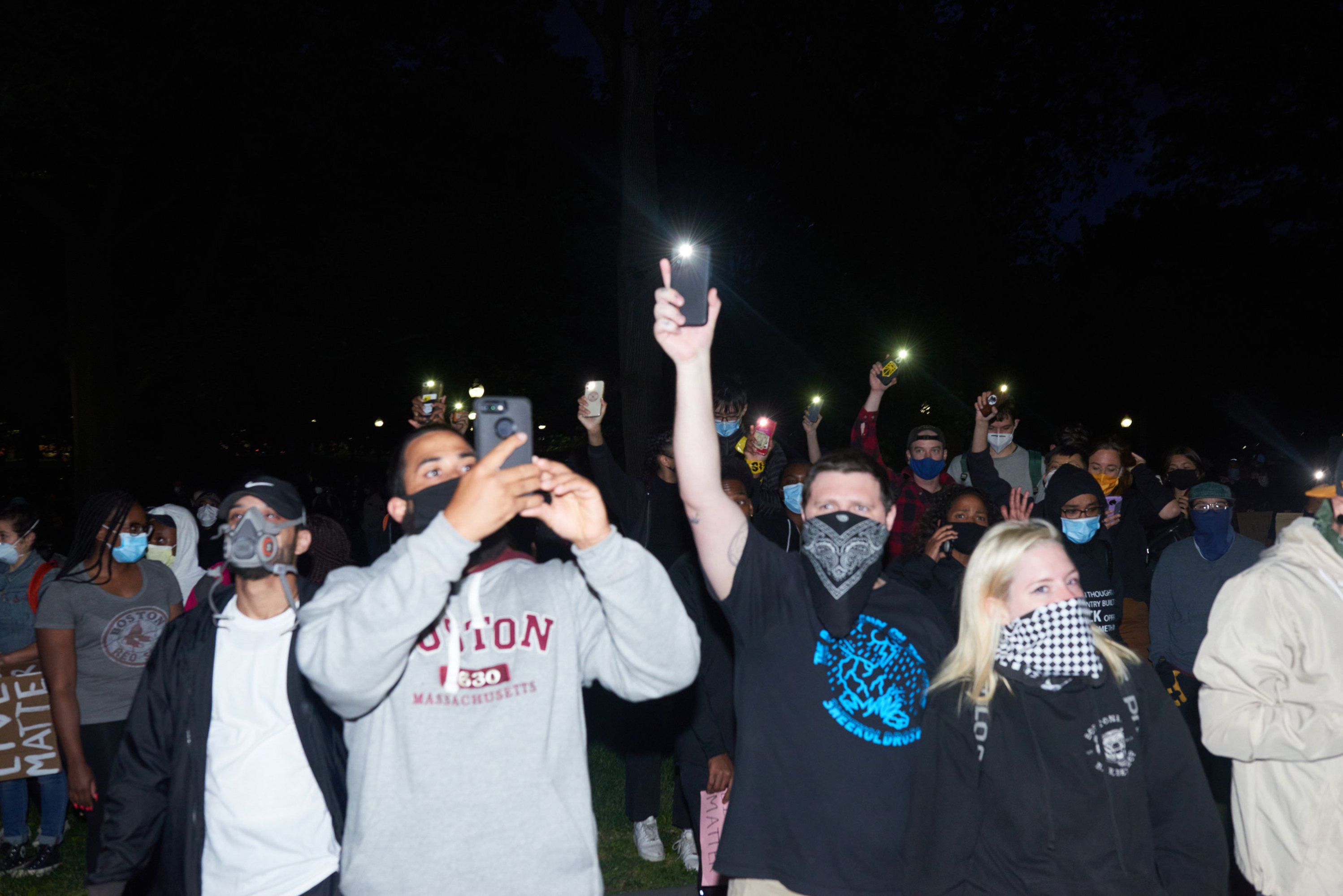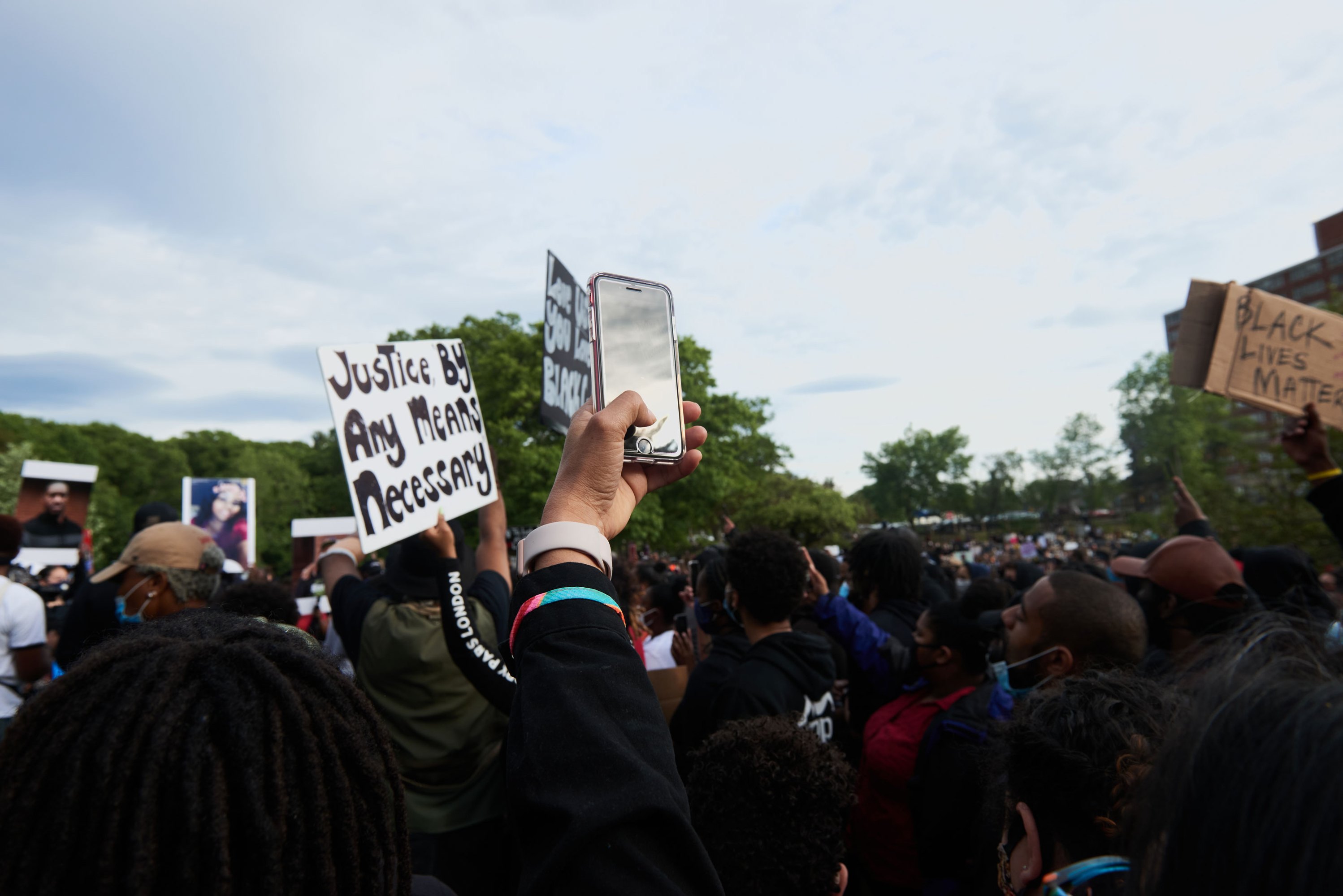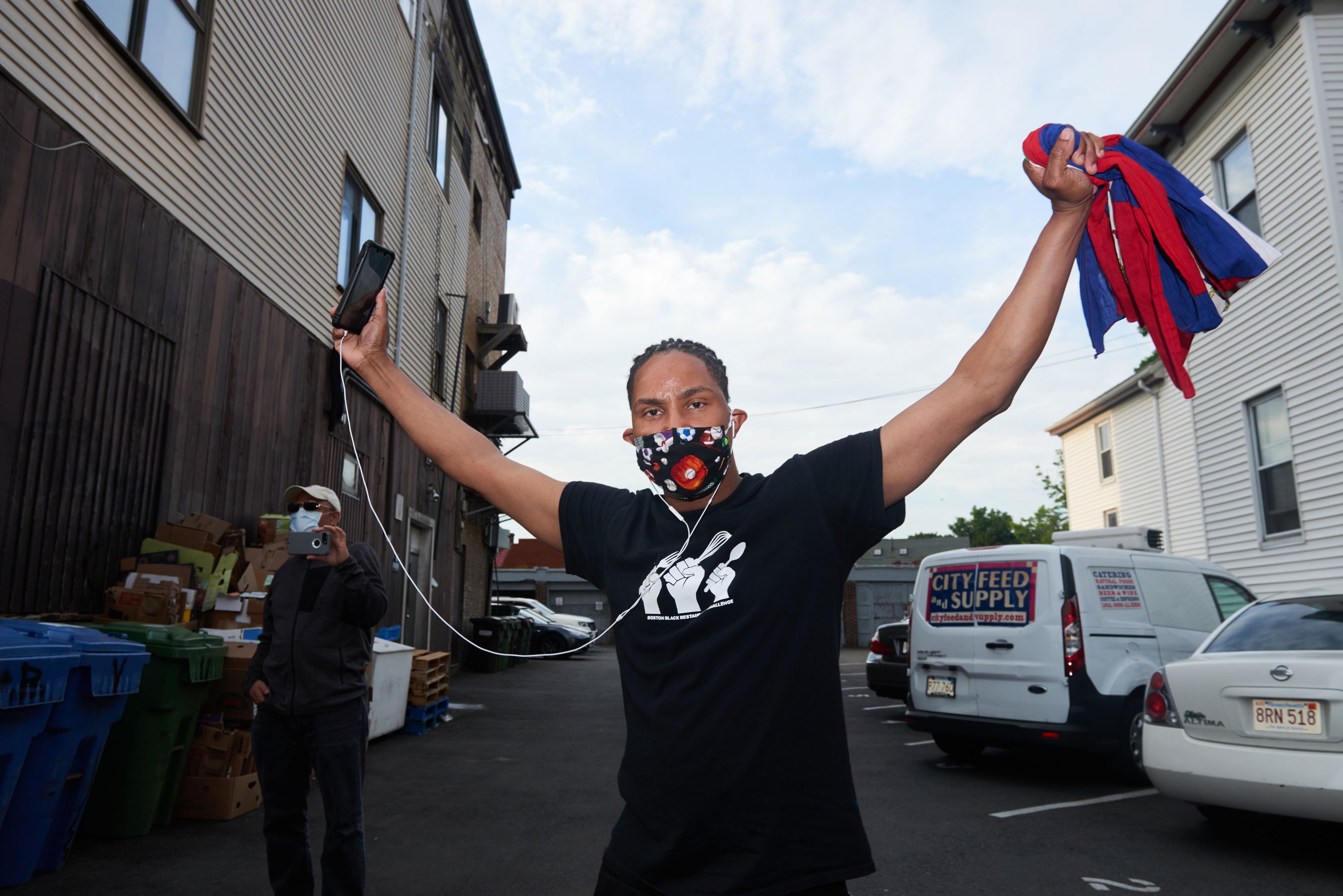Of all the videos that were released after George Floyd’s murder, the one recorded by 17-year-old Darnella Frazier on her phone is the most jarring. It shows Officer Derek Chauvin kneeling on Floyd’s neck as Floyd pleads, “Please, please, please, I can’t breathe,” and it shows Chauvin refusing to budge. A criminal complaint later states that Chauvin pinned Floyd’s neck for 8 minutes and 46 seconds, past the point where Floyd fell unconscious. In the footage, Chauvin lifts his head and locks eyes with Frazier, unmoved—a chilling and devastating image.
Documentation like this has galvanized millions of people to flood the streets in over 450 protests in the US and hundreds more in dozens of countries around the world. It’s not just this killing, either. Since the protests have broken out, videos capturing hundreds more incidents of police brutality have been uploaded to social media. A mounted officer tramples a woman. Cop cars accelerate into a crowd. Officers shove an elderly man, who bashes his head when he hits the pavement, and walk away as his blood pools on the ground. One supercut of 14 videos, titled “This Is a Police State,” has been viewed nearly 50 million times.
Once again, footage taken on a smartphone is catalyzing action to end police brutality once and for all. But Frazier’s video also demonstrates the challenge of turning momentum into lasting change. Six years ago, the world watched as Eric Garner uttered the same words—“I can’t breathe”—while NYPD Officer Daniel Pantaleo strangled him in a chokehold. Four years ago, we watched again as Philando Castile, a 15-minute drive from Minneapolis, bled to death after being shot five times by Officer Jeronimo Yanez at a traffic stop. Both incidents also led to mass protests, and yet we’ve found ourselves here again.
So how do we turn all this footage into something more permanent—not just protests and outrage, but concrete policing reform? The answer involves three phases: first, we must bear witness to these injustices; second, we must legislate at the local, state, and federal levels to dismantle systems that protect the police when they perpetrate such acts; and finally, we should organize community-based “copwatching” programs to hold local police departments accountable.
The good news is there are already strong indications that phase one is making an impact. “There have been so many different moments that should have been the powder keg, but they just weren’t,” says Allissa V. Richardson, an assistant journalism professor at the University of Southern California who recently wrote a book about the role of smartphones in the movement to end police brutality. “I think that this is different.”
PHILIP KEITH
I. Witnessing
First, it’s important to acknowledge where smartphones have brought us so far. Many critics have argued that they have fallen short of ending police violence, but this goal also couldn’t be achieved without them. To mobilize change against a given injustice, there must first be a majority consensus that the injustice exists.
This has been particularly true in the fight against racist oppression in America. Throughout the nation’s history, black Americans have persistently had to counteract widespread disbelief about the violations they face. To do so, they have relied on witnessing and documentation.
“We have always, throughout each era of domestic terror against black people, had some kind of visual proof—beginning with slavery, which then gave way to lynching, which then gave way to police brutality,” Richardson says. “Through each of those eras, you’ve had so-called black witnesses who have used the technology of their day to shine a light on racism.”
“Finally, we won’t have to carry this whole struggle on our own.”
Allissa Richardson
For example, during the first half of the 1800s, freed slaves like Frederick Douglass relied on newspapers and the spoken word to paint graphic depictions of bondage and galvanize the formation of abolitionist groups. During the early 1900s, investigative journalist Ida B. Wells carefully tabulated statistics on the pervasiveness of lynching and worked with white photographers to capture gruesome images of these attacks in places she couldn’t go. Then in the mid-1950s, black civil rights leaders like Martin Luther King Jr. strategically attracted broadcast television cameras to capture the brutal scenes of police dogs and water cannons being turned on peaceful demonstrations.
Witnessing, in other words, played a critical role in shocking the majority-white public and eliciting international attention. Whites and others allied with black Americans until the support for change reached critical mass.
Today smartphone witnessing serves the same purpose. It uses imagery to prove widespread, systemic abuse and provoke moral outrage. But compared with previous forms of witnessing, smartphones are also more accessible, more prevalent, and—most notably—controlled in many cases by the hands of black witnesses. “That was a real transition,” says Richardson—“from black people who were reliant upon attracting the gaze of mainstream media to us not needing that mainstream middleman and creating the media for ourselves.”

PHILIP KEITH
This is also what makes smartphones more powerful than police body cameras, which grew popular after Mike Brown’s death in 2014 and have received renewed attention in the last few weeks. Why rely on the presence of bystanders when police could be monitored at all times? Because bodycams are controlled by the police themselves, so they don’t produce the same transparency and accountability. They point in the wrong direction, they’re easily switched off, and in some cases they have been used to falsify evidence. Because policies for handling bodycam footage are written by police departments, there is also little accountability for releasing raw, unredacted footage (as in the case of Floyd). In 2017, footage from 40 of the 105 police killings captured by bodycams never saw the light of day, according to an analysis by the advocacy nonprofit Upturn.
One of the largest randomized trials ever conducted on the technology, involving more than a thousand officers, found no statistical difference in behavior between those who wore cameras and those who did not. “Bodycams reinforce the power in the position of a police officer,” says Sam Gregory, program director of the international human rights nonprofit Witness.
So smartphones are still the best tool for proving police brutality and shifting public opinion. And early research from Richardson’s team has noted several indicators that they have already done so.
By tagging photos of protesters by race, for example, they have found that the current demonstrations are far more diverse than previous police brutality protests. This suggests that, as with historical examples, other racial groups are now readily allying with black people. By analyzing the news and social media with natural-language processing, they have also found that discussion about whether the victim was a respectable person or did anything to deserve violent treatment has been less prevalent in the case of Floyd than others killed by police.
Richardson has found this same shift to hold true in focus groups and interviews. In the past, white people often expressed sentiments like “This person was no angel,” she says, but the tone now is completely different. Even though Floyd was arrested on charges of using a fake $20 bill, “they say, ‘You know what? We are in the middle of a pandemic. I would probably do the same thing,’” she says. Then they point to the long string of killings that made it impossible for them to deny racism and police brutality any longer: George Floyd, Ahmaud Arbery, Philando Castile, Alton Sterling, Eric Garner.
Police killings of black Americans caught on publicly-released video
In MIT Technology Review’s own analysis of protests, we also found that this moment looks substantively different. As of June 9, Floyd’s death has triggered 680 protests, more than four times as many as any previously police killing captured in publicly released video. A compilation of polling data from political blogger Kevin Drum confirms the same. In the last six years, white Americans have slowly converged with black Americans on the belief that police brutality is a major cause of violence.
“These videos are definitely making people who may have been in denial about African-Americans’ current oppression unable to deny that anymore,” Richardson says. “African-Americans are saying, ‘Finally, we won’t have to carry this whole struggle on our own.’”
II. Legislation
But filming can’t solve everything. The unfortunate reality is that footage of one-off instances of police brutality rarely leads to the conviction of the officers involved. Analysis by Witness suggests that it usually leads, at most, to victims’ being acquitted of false charges, if they are still alive.
Some of this can be changed with better tactics: Witness has found, for example, that it can be more effective to withhold bystander footage until after the police report is released. That way police don’t have an opportunity to write their report around the evidence and justify their actions by claiming events off screen. This is what the witness Feiden Santana did after the fatal shooting of Walter Scott, which played a crucial role in getting the police officer charged with second-degree murder.
But then again, this doesn’t always work. The deeper problem is the many layers of entrenched legal protections afforded the police in the US, which limit how effective video evidence can be.

PHILIP KEITH
One of the more notorious examples is “qualified immunity,” a legal doctrine that gives government officials, including police officers, special protection from being held liable for violating the Constitution. “It indicates that police officers get special immunity for the things that they do while they’re working,” says Dia Kayyali, Witness’s program manager for tech and advocacy. “Even when they’re obviously engaged in misconduct, they are still, just by virtue of their position, protected from lawsuits.” This is the primary way that police officers have avoided convictions even in the face of irrefutable video evidence.
There’s also the “objective reasonableness” standard, established 31 years ago with the US Supreme Court case Graham v. Connor, which asks the court to consider whether an officer was “reasonable” to use deadly force in a given situation. “You’re supposed to put yourself in the shoes of the police officer,” Kayyali says. “That’s the whole problem: the perspective of the police officers is broken.”
And then there are the so-called “police bills of rights,” laws that exist under different names in almost every state to protect an officer’s privacy. In effect, it makes it virtually impossible to pull public records on an officer’s behavior, meaning a one-off recording of misconduct stays a one-off recording. You cannot collect more evidence or mount a broader case to demonstrate patterns of abuse.
“Now we’re in a phase where substantive reform is being talked about.”
Allissa Richardson
That’s why smartphone witnessing must be coupled with clear policy changes, says Kayyali. Fortunately, given the broad base of support that has coalesced thanks to smartphone witnessing, passing such legislation has also grown more possible.
Since Floyd’s death, a coalition of activists from across the political spectrum, described by a federal judge as “perhaps the most diverse amici ever assembled,” has asked the US Supreme Court to revisit qualified immunity. So have Justices Clarence Thomas and Sonia Sotomayor, who represent the court’s opposite ideological poles. In Congress, Senate and House Democrats have introduced a bill that would make it easier to prosecute law enforcement officials and create a national registry for tracking police misconduct. At the state level, efforts have reignited in New York to repeal its police bill of rights, known as law 50-A.
On the streets as well, protesters have been calling for their local jurisdictions to “defund the police.” And on June 7, at a Sunday afternoon rally, the Minneapolis city council announced majority support for a move to disband the police department altogether. Both Kayyali and Richardson say that such developments are new. “Now we’re in a phase where substantive reform is being talked about,” Richardson says.
III. Copwatching
So we enter phase three: thinking about how to actually change police behavior. An answer may be found with Andrea Pritchett, who has been documenting local police misconduct in Berkeley, California, for 30 years.
Pritchett is the founder of Berkeley Copwatch, a community-based, volunteer-led organization that aims to increase local police accountability. Whereas bystander videos rely on the coincidental presence of filmers, Copwatch members monitor police activity through handheld police scanners and coordinate via text groups to show up and record at a given scene.
Over the decades, Copwatch has documented not just the most severe instances of police violence but also less publicized daily violations, from illegal searches to racial profiling to abuse of unhoused people. Strung together, the videos intimately track the patterns of abuse across the Berkeley police department and in the conduct of specific officers.
In September of last year, armed with such footage, Copwatch launched a publicity campaign against a particularly abusive officer, Sean Aranas. The group curated a playlist of videos of his misconduct and linked it with a QR code posted on flyers around the community. Within two months of the campaign, the officer retired.

PHILIP KEITH
For all the awareness that bystander videos have raised at the national level, Pritchett believes it’s this type of local work that has to continue the momentum. It’s not just about gathering footage, she says, but about collecting intentional footage that has somewhere to go.
In May, Copwatch launched a new database in partnership with Witness that allows Berkeley community members to submit their own footage. The database isn’t public, to avoid privacy issues—law enforcement officials have been known to run such footage through face recognition software to harass bystanders after the fact. But it tags and catalogues submitted videos on the basis of what they show, which makes it easier for the organization to search them for patterns and expand its playbook: once a certain amount of footage is assembled about a given issue, it will use the videos to mount class action lawsuits and publicity campaigns.
“Then the community could take action before they kill again.”
Andrea Pritchett
This is the type of organized, community-based witnessing that Kayyali supports as well. “We need to shift our tactics, because it’s 2020,” they say. “It’s unfortunately not surprising anymore to see someone post on your Facebook feed a video of black men being shot.” Using images like that is meant to incite action, but sometimes it’s more traumatizing than helpful.
The database also gives the community a greater sense of ownership. “That’s what I love about it: it’s grassroots,” Pritchett says. “Communities submit this information to the people that they trust. So it’s not some detached, mechanical, technological project. It’s a living, breathing community of support through access to information.”
Pritchett encourages more local organizations to adopt a similar strategy, and Copwatch has launched a toolkit for groups that want to create similar databases. Ultimately, she sees it not just as an information collection mechanism but also as an early warning system. “If communities are documenting—if we can keep up with uploading and tagging the videos properly—then somebody like Chauvin would have been identified long ago,” she says. “Then the community could take action before they kill again.”
Additional reporting contributed by Tate-Ryan Mosley.
